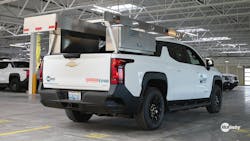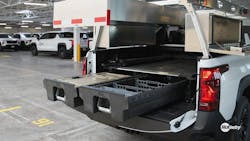Here’s how Silverado EVs perform in a work truck fleet
Key takeaways:
- McKinstry aims for a 100% electric fleet to reduce its carbon footprint, currently operating 114 EVs.
- Silverado EVs provide benefits like quieter operation and improved ride comfort, though adding weight can impact battery range.
- McKinstry uses various charging solutions, including home, campus, and public charging, effectively minimizing related challenges.
Having an electric fleet vehicle is becoming less of a rarity and more of a natural evolution for two types of fleets: those with sustainability goals and those that want to save money on fuel and maintenance.
McKinstry, a national construction and energy services firm with locations in nearly all four corners of the U.S., belongs in the former category. The nationwide company has a fleet of approximately 860 vehicles. Of those 860 vehicles, 114 are electric: a few Rivian R1Ts, Chevrolet Blazer EVs, and Chevrolet Equinox EVs. However, the majority of the EV fleet—100 to be exact—are Silverado EVs.
The goal is to eventually have a 100% EV fleet.
McKinstry is “on the leading edge of technology,” Ryan Winchester, McKinstry’s fleet manager, told FleetOwner. “EVs are obviously right there in that space. We're not doing this because it's a popular or unpopular thing to do. We're doing it because we want to reduce our carbon footprint here at McKinstry, because we like to do things that are good for our environment and good for the places that we work—our communities.”
Silverado EV in fleet operations
McKinstry’s electrification journey began several years ago. It received its first few electric vehicles, Rivian R1Ts, all the way back in 2017.
But the Rivian pickups, while great for supervisors, weren't suitable as work trucks for McKinstry's construction needs, according to Winchester. When GM announced an electric version of the Silverado, the fleet ordered 100 trucks immediately.
To be a McKinstry work truck, a vehicle needs space to handle extra upfits, extra weight, and ample storage. The Silverado EV, as a full-size pickup, allows just that, Winchester said. Further, the fact that it’s an EV allows for even more storage space with the vehicle’s front trunk.
See also: Chevrolet BrightDrop 400 review: An EV built for delivery
Silverado EV performance
Winchester thinks that in some ways, the Silverado EVs' performance is superior to that of an ICE pickup.
“They're quieter, they're more comfortable, and they're smoother,” Winchester said. “The EV Silverados with the ... [EV battery] weight there—they're just a better riding vehicle. Long-distance driving ... is more comfortable than an ICE vehicle.”
He also appreciates the absence of typical vehicle engine noise.
“You can drive down the road and have a regular conversation,” Winchester said. “You don't have to raise your voice at all. You don't even have to have the radio up loud in them.”
However, there are some important factors to consider when comparing an EV with an ICE vehicle—especially in a work truck application. One of the most important being the vehicle’s weight-to-range ratio.
Though McKinstry needed a full-size electric pickup for its upfits and equipment, loading the vehicle with extra weight sacrifices battery range. One of McKinstry’s Silverado EVs lost 20 miles of range after being equipped with 520 extra pounds of upfits, Winchester said.
While a similar effect happens with an ICE pickup’s fuel mileage after adding upfits, the EV driver’s experience is going to be vastly different considering public chargers aren’t as prevalent as gas stations.
Thankfully for Winchester and his drivers, the Silverado EV automatically calculates its own weight via sensors and adjusts the vehicle’s range accordingly. Not only does the Silverado EV sense weight, it also takes driver behaviors into consideration.
“If you’re hot-rodding everywhere you go around town in it, it starts to calculate how heavy you are on the accelerator, and the computer starts to decrease its range so that it’ll tell you that it’s time to charge it sooner,” Winchester explained.
See also: Driving an electric cargo van vs. ICE cargo van
How McKinstry charges its EVs
While other EV fleets have found charging to be the biggest EV-associated headache, McKinstry’s charging challenges have been minimal, according to Winchester. The company uses all methods of charging that are available to it to ensure its fleet is charged and ready; this includes charging at drivers’ homes, campus charging at McKinstry facilities, and public charging.
Perhaps one of the biggest reasons why charging hasn’t been much of a headache for McKinstry is because the company completes its own charger installations on its campuses. Winchester said that the only problem installation teams have run into so far is power constraints.
“Depending on how many charges you put into a building, you start to get limited on the power usage because you only have so much power coming in,” Winchester said.
As for home charging, McKinstry uses its fleet management providers to facilitate that.
While McKinstry facilitated and initiated the buildout of the charging infrastructure in-house, Winchester said GM is ready and able to help when they need additional electrification expertise.
One way GM assists McKinstry is by analyzing telematics and charging data to help the company decide how best to implement EVs within the fleet.
“They're going over all the data using telematics and helping us with ... plans of rollout for the next line of EVs that we'll be getting,” Winchester said.
According to Winchester, it works like this: General Motors Envolve—the team dedicated to working specifically with commercial customers on all things fleet—looks at McKinstry’s fleet usage to determine the routes best suited for electrification. GM alerts McKinstry of routes under 200 miles, where electrification with at-home charging will be no problem. Then for other routes, perhaps routes that travel more than 400 miles a day, GM shows McKinstry how electrification would be possible with adequate charging infrastructure.
“Right now, it wouldn’t make sense to deploy 50 EVs into Montana because the infrastructure is not there,” Winchester said. “In that way, [GM Envolve has] really started to become more involved as we get into the next wave of EVs.”
See also: Greenlane’s first EV truck stop opens with grand plans for trucking’s future
Silverado EV impressions
As with charging, overall implementation of the Silverado EV into the McKinstry fleet wasn’t much of a daunting task. Getting drivers on board didn’t pose a problem as McKinstry first distributed the EVs to drivers on a volunteer basis, Winchester said. This also gave Winchester and fleet leaders the time to iron out the wrinkles of running EVs in a primarily ICE fleet with drivers who wanted to be in them.
There were some fluke incidents, such as the time a driver shifted the Silverado EV to drive when it was still charging. This triggered a safety redundancy, forcing a tow. But “outside of that, for the most part, there hasn't really been too many issues,” Winchester said. “It's been pretty easy.”
Along with the Silverado EVs’ ease of implementation in the fleet, Winchester said the fleet is also saving money on fuel.
“I had a guy [who spent] roughly $1,200 a month in gas,” he said. “He's now down to $600 in charging.”
When spread across an entire fleet, that’s a significant savings. Another advantage of EVs that McKinstry found is decreased maintenance needs, requiring only regular tire rotations and pivot point lubrication, Winchester said. Additional maintenance includes occasional OEM updates, which are conducted over the air. Drivers can activate these updates at the push of a button when they return home at the end of the day.
Overall, Winchester and McKinstry are pleased with the Silverado EVs’ performance in the fleet. Winchester’s advice to other fleet leaders is to just do it.
“Once you do it and you realize, ‘Oh, this isn't really that big of a deal,’ then it makes it easier to keep going forward,” Winchester said.
But he cautions fleets to grow “responsibly,” implementing small batches of EVs at a time to ensure they’re working properly, that drivers are acclimating to them, and that they make sense for your fleet.
About the Author
Jade Brasher
Senior Editor Jade Brasher has covered vocational trucking and fleets since 2018. A graduate of The University of Alabama with a degree in journalism, Jade enjoys telling stories about the people behind the wheel and the intricate processes of the ever-evolving trucking industry.




